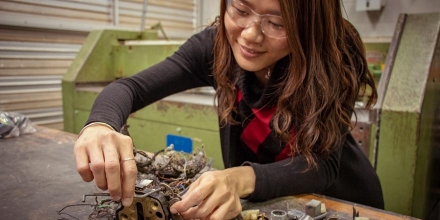Are newer products more recyclable?
Consumer products are increasingly being kitted out with technology – from mobile phones to cars. But at the same time, there’s also demand for more sustainable and environmentally friendly products. Can these two desires be compatible?
Associate Professor Matthew Doolan and Dr Vi Kie Soo, researchers at the Australian National University, hope to answer these questions and look for ways to improve the environmental impacts of technology.
One possibility is to reduce the energy consumed by products during their use and production. For instance, in vehicles, this can be achieved by using stronger materials to make cars lighter and using electric motors to improve the efficiency.
Another key way we can minimise environmental impact is by reducing waste at the end of a item’s useful life. This is known as a ‘circular economy’, where the materials from highly-recycled products can be turned in to a new item. This is already true to an extent, but there are plenty of new challenges associated with recycling increasingly complex products.
Associate Professor Matthew Doolan believes it’s important to look at approaches to ensure valuable materials are not lost into the waste stream.
“By not recovering these materials at the end of life we are losing a valuable resource and creating a waste problem,” said Associate Professor Doolan.
Electronic devices frequently change their design and materials. For instance, mobile phones and vehicles experience major development and changes over time.
On top of this, we’re seeing stricter legislation on things like vehicle emission regulation, and end-of-life vehicle (ELV).
Legislation encourages vehicle designs that incorporate lightweight materials and multi-material combinations. But as a result, there’s limited choices for large-scale production, and cars require mechanical fasteners that are feasible for joining different material types.
“Although multi-material vehicle designs help improve vehicle emissions while they’re in use, they have created increased challenges for the recycling sector. It can be difficult to recover materials of high value or prevent the loss of materials in the waste stream due to the current shredder-based recycling practices,” said Dr Soo.
Developments in technologies can also lead to shifting values for the recycling sectors. For instance, the shift towards electric, automated vehicles in the market, has shown an increasing use of electronic components and copper material that are not well recovered in current ELV recyclers. These materials commonly end up in the waste stream. Or worse, they can contaminate other valuable streams, since things like copper wires and electric motor winding are difficult to recover due to enclosure and entanglement.
Moreover, the changing battery types also lead to challenges in material recovery due to the lack of demand for certain materials. Traditionally, the recovery of steel scrap from ELV has been the focus so recycling facilities are setup to target steel recycling.
As vehicle technology evolves, the recycling sector needs to adapt to the shift in material values to minimise waste and maximise revenue from the changing products.
“It is important to start thinking on how to design products for multiple material reused since we are living in a world with finite sources,” said Dr Soo.
Shifts in technology and consumer patterns will continue to create challenges in the recycling industry from collection up to material recycling.
“Unfortunately, the challenges common for all consumer products – including electronic devices and household equipment – are also faced by the industrial sectors with building, wood, and other industrial waste.
“There is a need to understand the life cycle implication of product from design, use, and up to the end-of-life phase. That’s why a collaborative effort between producer, consumer, and recycler plays such a key role in ensuring effective use of limited resources,” said Dr Soo.
Dr Vi Kie Soo is a lifecycle engineer from the Australian National University. She works closely with the Australian Research Council Training Centre in Lightweight Automotive Structures (ATLAS) led by Associate Professor Matthew Doolan and Professor Paul Compston. Along with two other PhD students, the ATLAS-ANU team emphasises on the whole of lifecycle assessment of vehicle with a focus on end-of-life recycling.
Search News
Latest News
News Archive
- March 2023
- January 2023
- October 2022
- June 2022
- October 2021
- September 2021
- July 2021
- June 2021
- March 2021
- December 2020
- November 2020
- October 2020
- September 2020
- August 2020
- July 2020
- June 2020
- May 2020
- April 2020
- March 2020
- January 2020
- December 2019
- November 2019
- October 2019
- September 2019
- August 2019
- June 2019
- April 2019
- March 2019
- October 2018
- September 2018
- August 2018
- July 2018
- May 2018
- March 2018
